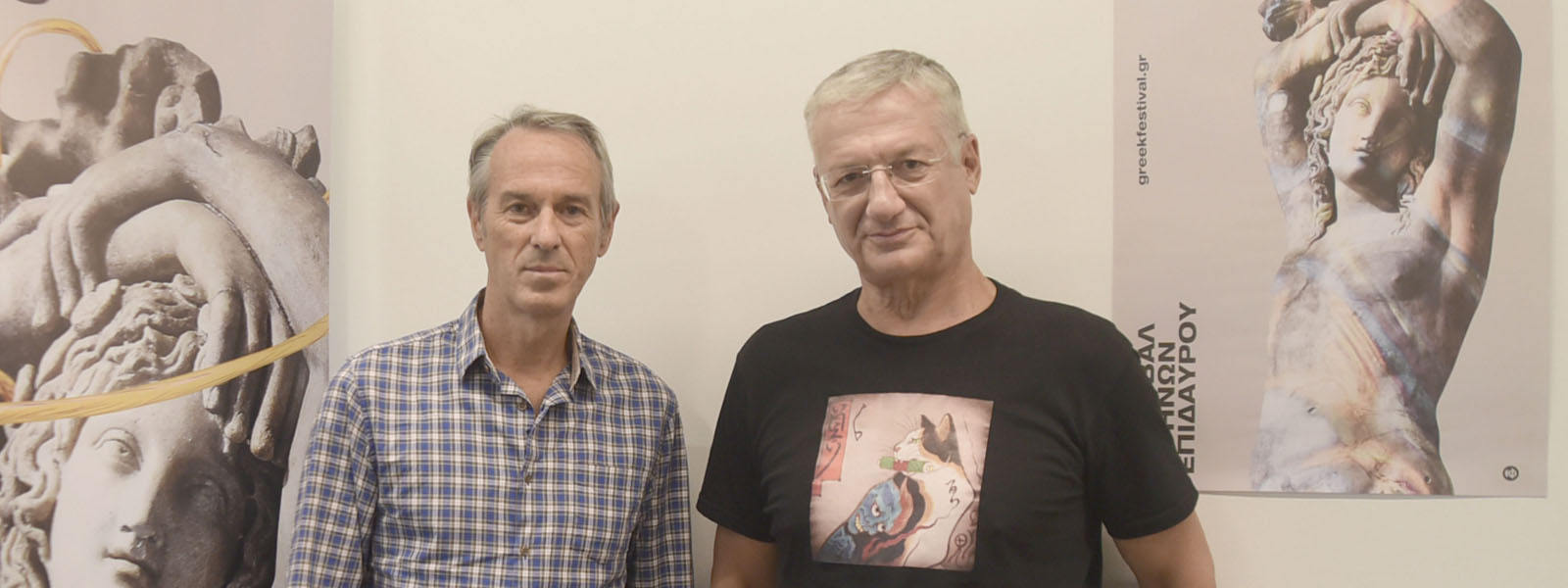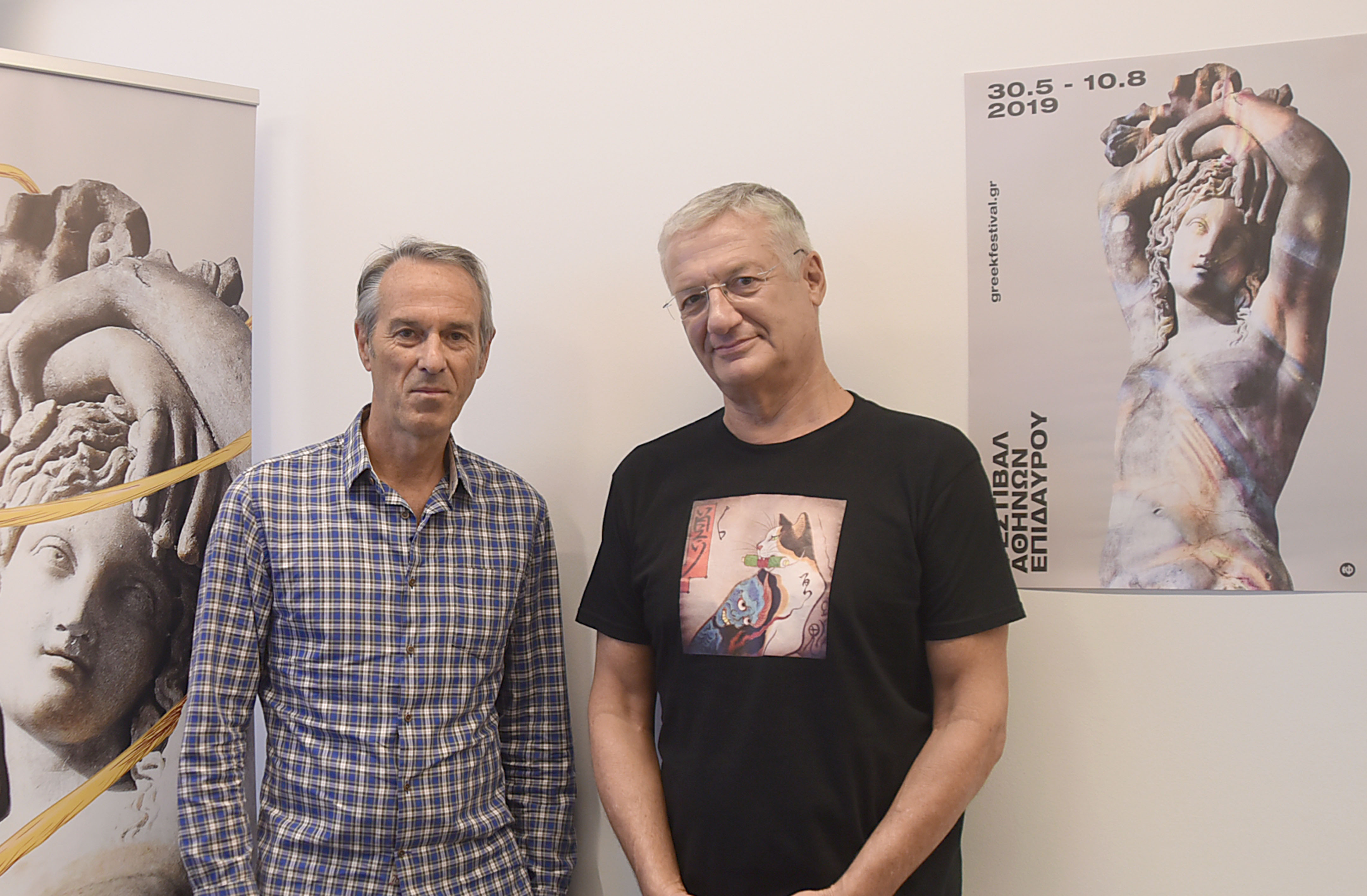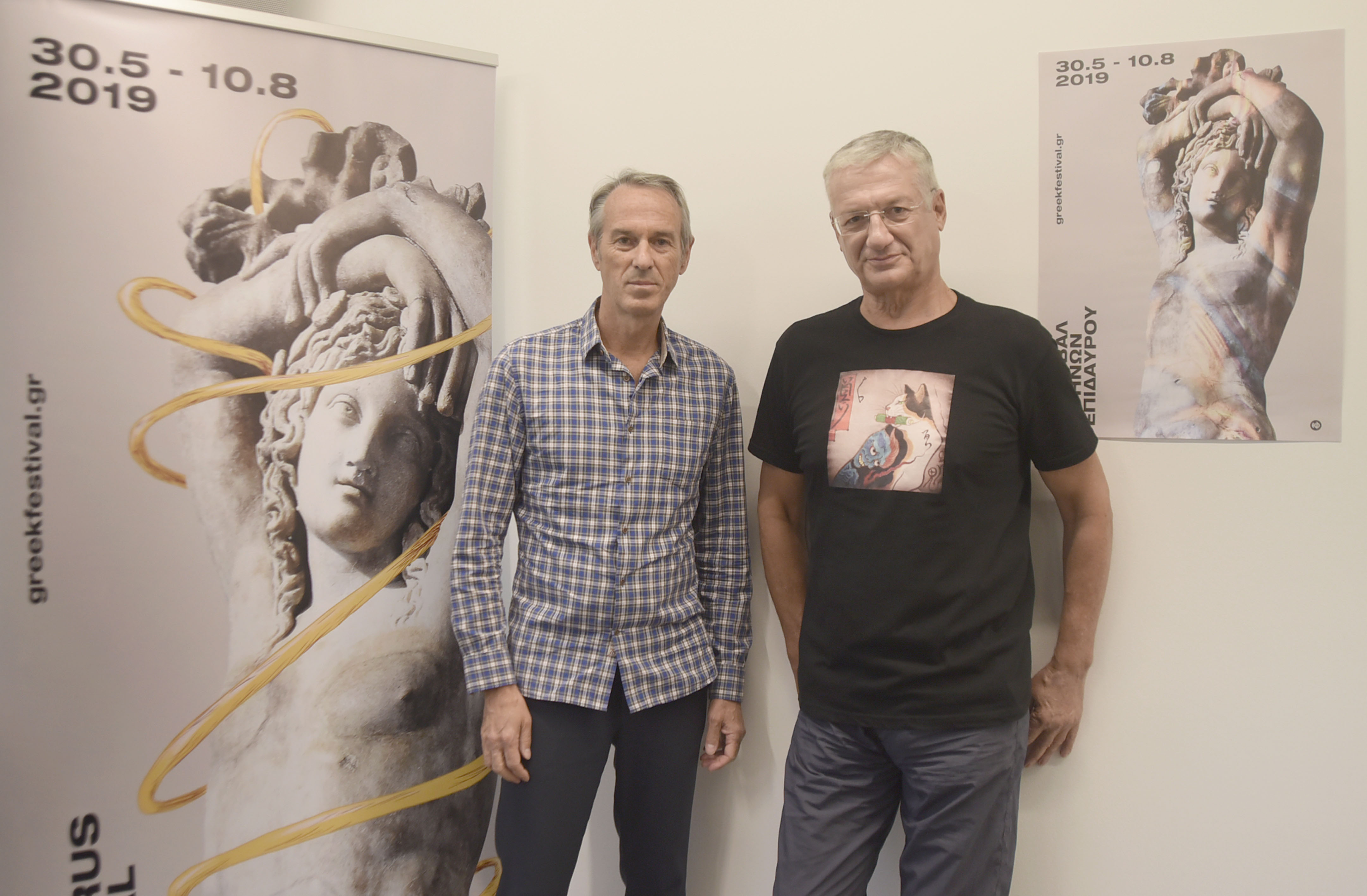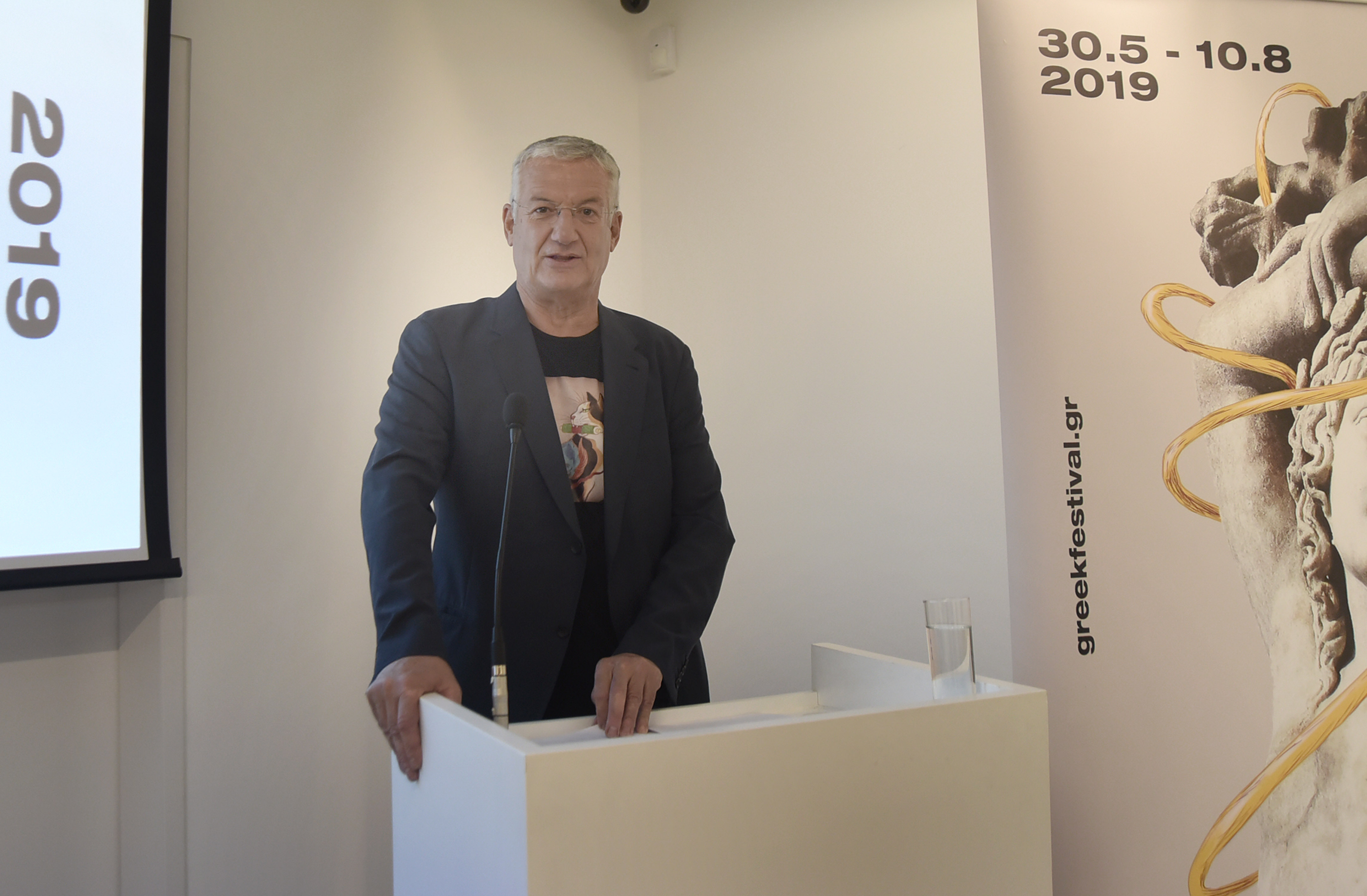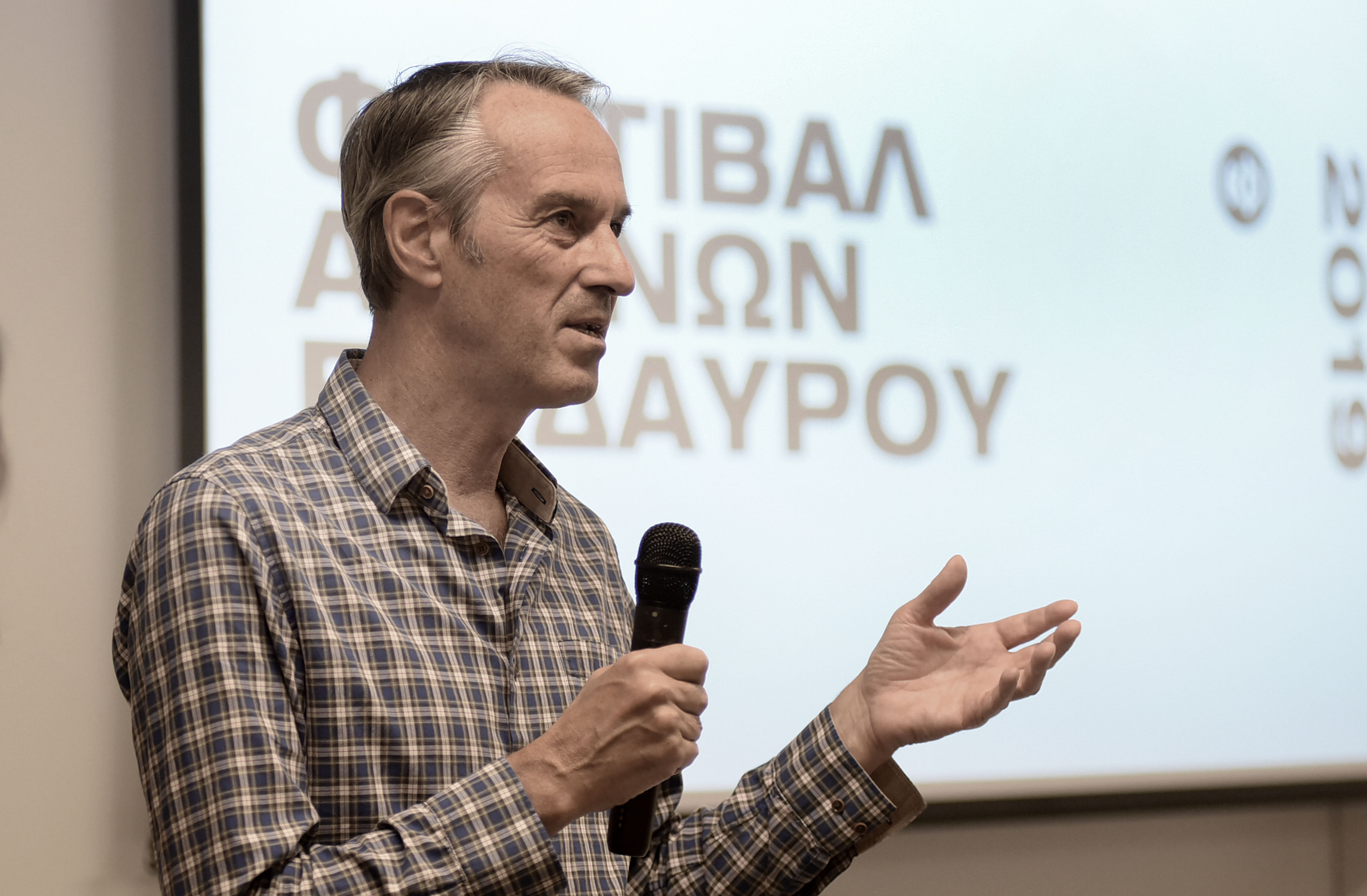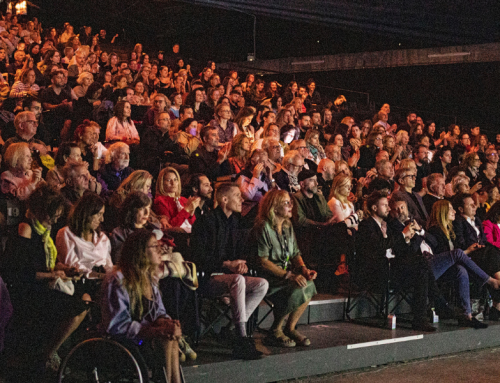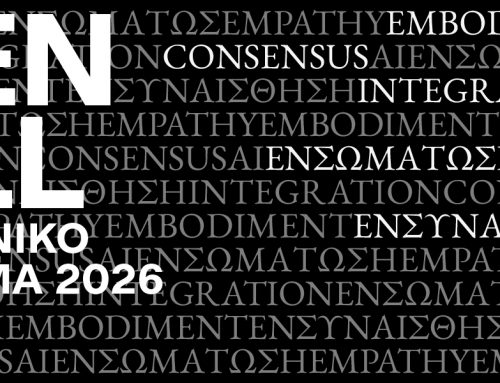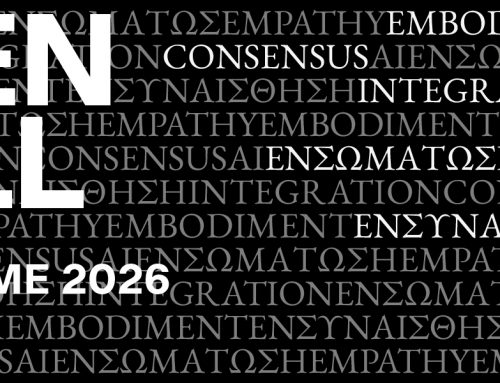A press conference looking on at the 2019 Athens & Epidaurus Festival was held on Wednesday 24 July. The Festival’s artistic director, Vangelis Theodoropoulos elaborated on this year’s programme. The internationally acclaimed Belgian director Ivo van Hove, who is about to make his Epidaurus debut, was also present. Van Hove discussed his collaboration with Comédie–Française and the performance Electra / Orestes which will be presented at the Ancient Theatre of Epidaurus on 26 and 27 July.
Today’s press conference, a look back on the 2019 Athens & Epidaurus Festival artistic programme, is aimed exclusively to journalists and critics. We have decided to hold this press conference in July and not after the 2019 edition of the festival officially comes to a close on 10 August, at which time most of you will probably be away on your summer vacation. This is also an opportunity for you to meet Ivo van Hove, one of the world’s foremost stage directors, who is in Epidaurus these days preparing Electra / Orestes and will soon join me on the podium to speak about his performance.
Given that this year’s programme marks the end of my three-year term as artistic director, it’s time we reflected back on this period and try to delineate what we have accomplished from 2016 to the present: what we strived for, what we succeeded in doing, and what will take even more perseverance and effort.
I have already stressed that I firmly believe in a Festival with a national and international character, acutely responsive to social reality, open to everybody; a Festival that is called upon to utilise the potential of a public institution to the utmost in order to respond to high demands such as cultivating audiences, boosting social cohesion, connecting art with society, and, of course, promoting and empowering domestic artists.
These were our mission statements and we took great pains to accomplish them, our primary goal being to sharpen the distinctive identity of our main venues (Ancient Theatre of Epidaurus, Little Theatre of Ancient Epidaurus, Odeon of Herodes Atticus, Peiraios 260, and the Opening to the City section), each of which constitutes an inextricable link in this multi-layered chain that we call Athens & Epidaurus Festival.
I believe that the years 2018 and 2019 marked the most complete and dynamic Festival summers of my term. Our efforts in recent years to expand collaborations with international and high-quality Greek productions in Epidaurus have begun to bear fruit, especially this year. In the summer of 2019, Epidaurus has so far (in 5 out of 8 scheduled weekends) welcomed a total of 52,747 theatre-goers. Meanwhile, a total of 79,202 attended performances at the Odeon of Herodes Atticus, without of course taking into account the upcoming Greek National Opera production of La Traviata and the scheduled China National Symphony Orchestra concert. A total of 18,433 spectators attended performances at Peiraios 260, while 2,440 individuals enjoyed Robert Lepage’s Kanata at the Athens Concert Hall. The Opening to the City attracted 5,845 visitors in Athens alone, with 17 of these events having free admission. Of course, it’s too early to draw comparisons with 2018, given that the 2019 programme has not even been completed yet. In addition to the two aforementioned, large Odeon productions, in Epidaurus we are still looking forward to watching Comédie-Française’s Electra / Orestes, The Clouds, Prometheus Bound starring Kathryn Hunter, and at the Little Theatre, Phaedra and Le Danaidi. Another crucial factor that must be taken into consideration is that this year our total number of productions is smaller, a conscious decision on our part, following reflection and self-criticism; we felt we had to cut down a bit on the number of venues and performances involved, in order to create a tighter, more focused programme that could more actively target audiences.
We decided to reinforce the musical character of the Odeon of Herodes Atticus, with emphasis on classical music, a decision that was vindicated by the impressive audience turnout for major orchestras and acclaimed soloists; orchestras such as the Wiener Symphoniker with Leonidas Kavakos as conductor and soloist, the Orchestra Giovanile Luigi Cherubini of the Ravenna Festival with Riccardo Muti as conductor and the Orchestre Symphonique du Luxembourg, and soloists including Yo-Yo Ma, Yuja Wang and Maxim Vengerov. As far as opera is concerned, the Greek National Opera premieres two brand-new productions of Norma and La Traviata, while the Armonia Atenea – The Friends of Music Orchestra and George Petrou presented Handel’s magnificent Alcina, with Myrtò Papatanasiu in the title role.
I will not elaborate on the hugely successful concerts of Jethro Tull, Loreena McKennitt, Dead Can Dance and Tindersticks, all of whom played to a full house, or concerts by major Greek composers and performers, a success that is largely to be expected. But to have the Odeon at full capacity in classical music concerts, a more demanding genre, is a great accomplishment in my opinion, gradually earned, the result of careful planning both in terms of programme-making and in terms of communication strategies. The 2019 programme was warmly received by audiences and critics alike, and the Odeon was packed in all concerts. The Odeon has once again become a priority for music lovers. Costa Pilavachi has served as our invaluable curator for Odeon productions.
Another outstanding moment at the Odeon was a dance performance by the world-renowned dancer and choreographer Anne Teresa De Keersmaeker, along with her Rosas company, making her Odeon debut with her own take on Bach’s 6 Cello Suites, performed by the famous cellist Jean-Guihen Queyras.
At Peiraios 260, a regular meeting point for avid theatre-goers and aficionados of avant-garde theatre, we have continued, in our own way, to pursue and highlight the dominant, contemporary trends in performing arts, theatre, and dance, both at an international and at a national level. This industrial venue welcomed, for the first time ever, a number of children-friendly artistic events, namely Mark Hadjipateras’ colourful Buiding Hope, a collaboration with the Museum of Greek Children’s Art, and two brilliant workshops for children, one held in collaboration with the Museum of Cycladic Art (which is kindly hosting us today) and the other workshop held in collaboration with Dora Androulidaki, active in the LGBT Berlin community, with drag queens narrating diversity-themed stories to children – an event that was not only entertaining for children but also proved to be a moving experience for the adults escorting them and was well-received overall.
With regard to contemporary Greek theatre, we focused on the issue of diversity through performances putting a spotlight on cases of individuals or groups at the fringes of society and attempting to bring to the fore the issue of collective responsibility and the need for social cohesion. I can’t list all these productions in detail here, but suffice it to say that all nine Greek productions at Peiraios 260 were created by up-and-coming directors and each of them was fascinating in its own way, a fact that was acknowledged and embraced by audiences. Our main standard for selection was directors themselves; theatre artists whom we wanted to introduce to a broader audience for their dynamics and potential and not merely for their already established artistic identity. Allow me here to explicitly refer to a performance I singled out, not only because it epitomises this year’s diversity theme, but also for artistic reasons: Horse in Love / The Absurdity of Love by director Eleni Efthymiou and the En dynamei group, a Thessaloniki-based collective of young artists with or without disabilities. This performance fully meets our criteria of what a Festival performance should be like, in terms of quality, scope, originality, freshness and boldness.
When it comes to the Greek programme, the Festival has another important, supportive role to play, being the only institution that can still give younger artists the opportunity to be tested on large-scale, more demanding stages than those of season theatres, side by side with international productions. The Festival can provide these artists with means for experimentation, for carving out a bold, singular style that could ultimately yield performances that could potentially break into the international festival circuit. In other words, our Greek programme and our international programme do not share the same goals. In the former case, it is a bit of a ‘gamble,’ as we support promising proposals and theatre artists, whereas in the latter case we choose internationally acclaimed artists or finished productions which have already made a splash abroad. In Greek theatre, that is, we take on a purely creative, productive role, as well as we should, representing a public festival on a par with other European festivals. Dimitra Kondylaki serves as our invaluable curator for Greek contemporary theatre, and also head of the Festival’s publications department.
By the same token, the Festival supports young Greek dance artists, including Kostas Tsioukas, Androniki Marathaki and the artistic duo Aris Papadopoulos – Martha Pasakopoulou, whose work Lucy will also be presented at the upcoming Kalamata Dance Festival. Let me also point out our exciting collaboration with the National School of Dance for the performance Growing!, in which the young generation of Greek dancers were invited to perform at the Festival, following the perspectives and instructions of established choreographers Ioannis Mandafounis, Christos Papadopoulos, Andonis Foniadakis and Cyril Baldy. As a reminder, we also held an artistic/educational exchange programme with the Fondazione Nazionale Della Danza / Aterballetto, and a collaboration with the Onassis AiR international residency programme of the Onassis Foundation.
Our international dance productions were well-received by audiences, including #minaret by the Lebanese Omar Rajeh, who carried us into the nightmarish world of the destroyed city of Aleppo in Syria through a drone flying over dancers’ bodies. On a different note, the rising Portuguese choreographer Marco da Silva Ferreira combined street dance with African influences, vividly bringing to life an electrifying universe of infectious energy. The world premiere of Boris Charmatz’s infini, an Athens Festival co-production, is a landmark, a reference point for our international identity, as in this case Peiraios 260 kicked off a tour that will include prestigious European festivals, such as Festival d’Automne in Paris, and major theatres in Brussels, Zurich and elsewhere. This performance perfectly proves why Charmatz is at the forefront of contemporary choreography, a pioneering artist who opens up new perspectives. At the same time, it demonstrates that the Festival is an institution that is willing to take risks and support exceptional avant-garde artists. The contributions of our dance curator Steriani Tsintziloni were instrumental in that respect.
Women artists were particularly prominent in this year’s international theatre programme. Among them, the South African Candice Breitz and her video installation Love Story, with its gripping accounts of refugees, raising questions about immigration and the power of narratives. Two other, equally electrifying, subversive and powerful female voices were Angélica Liddell (Genesis 6, 6-7) and the performer nora chipaumire (#PUNK).
Diversity is the key word that encapsulates the rationale behind this year’s international programme, which covered a wide range of artistic styles, running the gamut from established theatre auters, who once again riveted audiences with their dense, poetic and meaningful imagery, such as Kanata by Robert Lepage and Ariane Mnouchkine’s Théâtre du Soleil, or Romeo Castellucci’s La vita nuova, to major artists first introduced to Greek audiences by the Athens Festival, a case in point being the Colombian Mapa Teatro, returning with their colourful, frenzied, political and melancholy Los incontados, to rising artists who are currently making a splash on European and international stages. Athenian audiences had the opportunity to enjoy younger artists in their Greek debut, including SAIGON by the French-Vietnamese Caroline Guiela Nguyen, a deeply moving performance about memory, nostalgia and history, the German-born Susanne Kennedy with her provocative, multimedia stage adaptation of Jeffrey Eugenides’ novel The Virgin Suicides, and the Swiss Thom Luz with his contemporary fairy tale Girl from the Fog Machine Factory. I must acknowledge the contribution of our new curator for international productions, Carolin Hochleichter, taking over from Matthias von Hartz, who was with us until the end of 2018 and is now artistic director of the Theater Spektakel in Zurich.
We are equally satisfied with the Opening to the City section. Launched in 2017 and running for the third consecutive year, the Opening to the City encompassed a number of events which did justice to our original intention to palpably connect art with citizens, institutions and collectivities/groups active in the city, effectively exposing individuals who are not necessarily part of our regular audience to the Festival.
Diversity was also the overarching theme here, and with that in mind, we held 19 events in Athens and 10 in Piraeus, the latter in collaboration with Nikos Diamantis, artistic director of the Piraeus Municipal Theatre. These events targeted a wide range of audience types and social groups, from the LGBTQI+ community in the Aphrodite* platform and the A New Era (?) performance to substance abuse, a source of inspiration for Ilias Poulos’ exhibition at the Victoria Square Project, featuring rare photographs of drug addicts from the interwar period, along with fascinating parallel events. We also hosted a number of audio walks jointly with the KETHEA Cultural Club. Furthermore, we hosted the Invisible tours of the Shedia street paper: guided tours through social organisations in central Athens (soup kitchens, homeless shelters, rehabilitation centres, day centres), with homeless people serving as guides and sharing their experiences with visitors.
The dance and theatre performances falling under the Opening banner were equally distinctive. A case in point was the performance that paid tribute to writer Marios Hakkas, presented in Kaisairiani by Zoi Xanthopoulou, with the (touching) participation of locals, as well as Thanassis Chalkias’ She Was Moved by Movies, a seductive blend of theatre and cinema.
We have also continued our extremely successful collaborations with a number of institutions, including the Athens Conservatoire, where once again this year a platform for young, rising musicians was held, paying tribute to cello, under the supervision of Dionysis Mallouchos. We have also renewed our collaborations with the Greek Film Archive and the Elliniki Etairia – Society for the Environment & Cultural Heritage, the latter featuring Manolis Korres’ popular guided walks.
In Epidaurus, we are quite happy to see that our efforts towards a more international orientation visibly bear fruit, as this year the ancient theatre welcomes world-renowned, avant-garde artists with star power. The 2019 Epidaurus curtain rose with Robert Wilson’s Oedipus. This week, Comédie-Française and their invited director, Ivo van Hove, will make their debut at the ancient Argolis theatre with the highly anticipated Electra / Orestes by Euripides. The Festival will draw to a close with a production of Prometheus Bound, an Epidaurus Festival and Municipal & Regional Theatre of Patras co-production (dir. Stavros Tsakiris), with Kathryn Hunter in the title role, performing in Greek for the first time in her career, in her Epidaurus debut.
International collaborations cannot be achieved with a snap of the fingers; they require long-term planning. Tellingly, our negotiations with the general administrator of Comédie-Française, Éric Ruf, began as early as autumn 2016! That being said, the international orientation of Epidaurus does not only rely on international productions, but also on the high quality and consistency of the overall programme. The Greek productions chosen for 2019 follow the same logic; it still takes a lot of work, though. It is important that all Epidaurus performances are created jointly with the Festival.
Reinforcing the international orientation of Epidaurus is a priority for a number of reasons. This ancient theatre, as a festival venue, must start being in dialogue with European festivals that present the crème de la crème of contemporary theatre, attracting international collaborations and making Epidaurus a destination for theatre-goers worldwide. However, this vision requires long-term planning.
We are also pleased with how things are turning out at the Little Theatre of Ancient Epidaurus, as acknowledged by critics in the last couple of years. The Little Theatre hosts alternative directorial approaches on ancient drama or other ancient or ancient-themed works, helping this venue to carve out its own, unique identity, and attracting a younger, restless audience. It was about time this beautiful Hellenistic theatre, situated by the sea, came alive, opening up to a more liberated and bold perspective on ancient texts. The Little Theatre converses with the Ancient Theatre. Meanwhile, the Epidaurus Lyceum adds an educational quality to the mix – an educational quality that is, in my opinion, proper to a festival.
The Epidaurus Lyceum was held for the third year in a row with the participation of celebrated Greek and international teaching staff. The Lyceum is an international summer school of ancient drama that we designed and realised in 2017 in collaboration with the Department of Theatre Studies, University of the Peloponnese, in Nafplion. The 2019 Lyceum programme was held on 2-16 July, and was attended by 105 students from 18 countries, with the participation of 22 teachers from 8 countries and 18 volunteers, plus the Festival’s Lyceum organising team.
For the second year in a row, 45 Lyceum students successfully applied for ECTS credits through the academic accreditation programme provided by the University of the Peloponnese.
I believe that this polyphonic, intercultural school of ancient drama is an institution that needs to take root, and not just because the continuous re-examination of perspectives and performative approaches of ancient drama in the genre’s very birthplace is and should be of interest to us, but also because the Lyceum has considerable benefits for the Festival itself. Let us not forget that it is younger audiences, effervescent and lively, who are, for the most part, fuelling Festivals worldwide. We have already achieved this at Peiraios 260 and the Opening to the City. Epidaurus will follow suit.
Our interest in connecting the artistic programme with the local community in Epidaurus and Argolis isn’t limited to the above. We have also developed a series of events once again realised this year with considerable audience participation: Educating Audiences in Ancient Drama enables audience development (students and adults alike) through their participation in experiential workshops, lectures and presentations, focusing on performances to be staged in Epidaurus during the summer. Starting this year, we have even had educational events seeing the participation of refugees. Two other educational events include the Dialogues event, a series of meetings and open workshops featuring directors whose performances are staged at the Epidaurus theatres, and Educating International Audiences, which encompasses experiential theatre workshops, lectures on ancient drama, attendance of Festival performances in Athens and Epidaurus, and guided tours in archaeological sites, designed specifically for groups of international visitors. These activities were attended in 2019 by over 1300 students, adults and visitors from abroad. This programme and the majority of the Festival’s educational events could be attended free of charge.
Moreover, we are having the Epidaurus Creative Workshop for children for the third consecutive year, running parallel to the performances at the Ancient Theatre of Epidaurus. Georgina Kakoudaki, our curator of educational programmes, must take credit for the Epidaurus Lyceum and the Argolis and Athens educational activities.
We have emphasised the educational character of the Festival in Athens, too. We have been consistently holding post-performance talks with world-famous theatre and dance directors and artists, moderated by the respective curators – an impressive number of spectators have sat through them.
Our ‘think tanks’, through which we are hoping to bolster collectivity in the performing arts, have also attracted visitors, as they offer a rare opportunity of meeting and collectively exchanging views on crucial issues. The first theatre symposium we held this year, “Greek.gr”, was linked to diversity as an all-encompassing theme of the 2019 programme. Our second theatre symposium, co-organised once again this year with the Hellenic Association of Theatre and Performing Arts critics, was dedicated to the relationship between theatre and criticism and was entitled “Critics, theatre and the new era: Dissecting an uncertain relationship.” The scope of these pluralistic, diversified, academic-level symposia was consolidated by the fact that the Bodossaki Foundation was interested in uploading them on the Foundation’s website (as they had done last year with our symposium on Loula Anagnostaki) – a practice which ensures that these symposia can continue to have a life of their own beyond the Festival and can be watched in their entirety by interested parties.
Regarding dance and education: last year, we launched Dance Day. Our expectations were fully met, both from our experience last year and even more so this year. The 2019 Dance Day consisted of a 9-hour programme, with 75 participants (both dance professionals and amateurs, of all age groups, with or without disabilities), with over 300 audience members attending five activities, four of which were participatory.
The 2019 parallel events also included workshops on theatre (a workshop for young directors run by Krzysztof Warlikowski) and dance (for dance professionals, at full capacity) and music (Yo-Yo Ma’s workshop in Kypseli).
Across the various aspects of the Festival, the main challenge for us was how to bring together the many different groups which collectively comprise society, making them meet, giving them food for thought and actively engaging them through art. At the same time, we aspired to give our productions a much-needed outward orientation, bearing international audiences in mind. Our surtitles policy was developed along the same lines, as, in addition to the Epidaurus performances, where we’ve traditionally had both Greek and English surtitles, we have added English surtitles in all Greek productions at Peiraios 260. Furthermore, starting last year, we are having Greek surtitles in all Greek productions, catering to the needs of the hearing impaired and for the convenience of all theatre-goers in general. Therefore, I believe that we’ve accomplished audience expansion to a large extent – an endeavour that requires vision, perseverance, consistency and continuity.
With regard to financial matters, in the last three years I managed the budget of the artistic programme without excesses, meaning that for the first time in the Festival’s history we didn’t need extra funds and we didn’t have to raise the budget, even though a raise is always in favour of the programme. The dozens of collaborations we clinched with institutions, foundations, organisations and individuals, often covering the costs of their productions at their own expense, contributed to that. The increase in the number of co-productions, audience members and accordingly ticket revenue were also instrumental. From a financial point of view, my three-year term had resulted in a surplus, as we expect it to be in 2019, when the fiscal year comes to an end and we have the full financial data in our hands.
My heartfelt thanks go to my team of artistic curators and my assistants who worked hard by my side; the board of directors and the Festival employees, my companions throughout these years; all the artists whose work was featured in the Festival and those whose work was not included; the journalists and critics who gave us their vote of confidence and promoted our work; the public and private organisations, sponsors and individuals who supported us, and, above all, the audiences who embraced our performances and events.
As a closing remark, allow me to say something a bit more personal. Next month, my three-year term comes to an end. The Athens & Epidaurus Festival, with its many and diverse venues, is a truly gigantic organisation. The workload was huge; we worked long hours. However, this was an invaluable experience for me, and it was this realisation that kept me going, that daily gave me strength and resilience. In the interests of our artistic programme, I visited many theatres and festivals around the world. I met significant artists and professionals whose devotion to their art makes them humble. I am grateful for this journey in my life, in spite of the difficult moments that came with it.
Warmest thanks go to the European Regional Development Fund for co-funding eleven performances as part of the Regional Operational Programme of Attiki 2014-2020; the Piraeus Municipal Theatre; the Greek Film Archive; the Athens International Film Festival; the Museum of Cycladic Art; the Onassis AiR international artistic and curatorial residency programme of the Onassis Foundation; the Victoria Square Project; the Museum of Greek Children’s Art; the Athens Conservatoire; the Elliniki Etairia – Society for the Environment & Cultural Heritage and the Organisations and Citizens Network for the Historic Centre of Athens; the Hellenic Chamber of Hotels and the Athens – Attica & Argosaronic Hotel Association; Marketing Greece; KETHEA; the Shedia street paper; the Athens Culture Net of the City of Athens; the Municipality of Nikaia – Ag. I Renti; the 18 ANO programme; STASY; the Dionysos – Zonar’s restaurant; the Athens International Airport; the Institut Français de Grèce; the Goethe-Institut; the Instituto Cervantes de Atenas; the Istituto Italiano di Cultura di Atene; the Embassies of Belgium, France, Germany, Switzerland, United States, Spain, Italy, Canada, Lebanon, Luxembourg and Portugal.
I wish you all a great summer!
Vangelis Theodoropoulos
Artistic Director of the Athens & Epidaurus Festival





